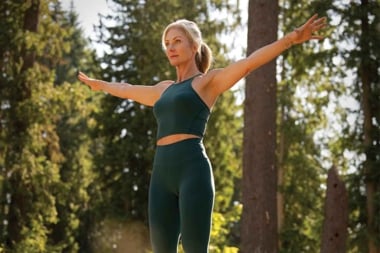
If youv'e ever strapped on a pair of skis or a snowboard without pre-winter training, you are most likely familiar with delayed-onset-muscle-soreness (DOMS).
If you’ve ever strapped on a pair of skis, a snowboard, or some snowshoes in your adult life, you are most likely very familiar with delayed-onset-muscle-soreness (DOMS).
DOMS is that nasty aching and stiffness that you experience a day or two after either learning one of these new sports, or after the first day of performing the sport after an extended break. In addition to muscle soreness, DOMS is also responsible for making you wonder, “How am I ever going to get back up again?” as you sit down gingerly at the breakfast table the morning after the first day of the season.
Prevent pain with prep
So how do you stop this silly nonsense and get rid of DOMS for good? Well, you can stop doing the activity that causes the pain in the first place, or you can condition yourself so that on your first day out on the slopes you don’t provide DOMS with the opportunity to accompany you back to your place when you return from those snowy hills.
The human body is an amazing machine. Give it a new and unexpected stress (like the first day on the slopes) and it will initially respond negatively. However, if you prepare the body for the stress it is about to encounter on the mountain, it will not let you down. It will allow you to perform your activity efficiently, injury-free—and also allow you to laugh and cough pain-free the next day.
Add these sport-specific movements to your regular gym routine to tailor your workout to your particular sport. Aim for a strength training program at least twice a week a minimum of four weeks before the season starts to ensure success when the snow starts to fall.
|
Wall Sit
|
|
| Snowboarding Mountain Climbers with a Tap
|
|
Walking Lunges
|
|
| Snowshoeing Hamstring Curls
Please note: this exercise must be performed on a slippery surface, such as hardwood or laminate flooring. |
|
Incorporate this drill in between your regular strength training exercises, and turn your program into a sport-specific workout and a calorie-burning circuit workout.
|
Navigating icy sidewalks
For our older generation, walking on ice and navigating through the snow can be challenging activities. Follow these simple fitness tips to improve your balance and coordination. Be sure to position yourself close to a wall or have someone spot you to stablize you in case you lose your balance.
- Stand on one leg while performing simple movements such as bicep curls and shoulder presses.
- Stand on a foam roller, lengthwise, and perform a lunge.
- Balance on one leg for 30 seconds with your eyes closed.
- Hike during the spring, summer, and fall months to improve your ability to walk over rocks, roots, and other uneven surfaces.









